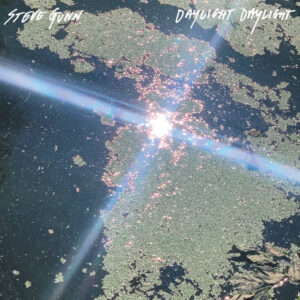Steve Gunn: Daylight Daylight
„Laughter in shadows
Where you used to stand
With all of us around
Particles bright
In my letter of light
Scattered the sea
The fools, they agree
It‘s all we know“

Ich habe mich oft zu einer Musik hingezogen gefühlt, in der vermeintlich nichts passiert, und doch so viel. Als ich dieses Album erstmals hörte, war ich auf Anhieb verblüfft. Zu wenig bin ich mit den Alben dieses Singer / Songwriters vertraut, um zu beurteilen, ob sich diese Art von Liedern schon früher bei ihm angedeutet hatten: nichts Zupackendes, Riff-Betontes , eher ein durchgängig verhaltendes, impressionistisches Flair, dem sich die ruhige Stimme bestens zugesellt. Orchestrale Klangfarben kommen ins Spiel, aber dermassen subtil und dezent, dass aufmerksames Lauschen die einzige Chance ist, dieser Musik nahezukommen. Als Vergleiche werden in Besprechungen hier und da Bert Jansch, Talk Talk und John Martyn ins Feld geführt, ich würde noch M. Ward nennen, was den leichten Rauch in der Stimme angeht – und wenn diesem wunderbaren Liederzyklus ein Thema zueigen ist, dann „traveling“. Auf jeden Fall wird es die Nummer 8 meiner Jahresendliste sein. Beim Hören wird man, wenn man nicht ratzfatz das Interesse verliert, sanft in das Gewebe dieser Songs hineingezogen, und haben sich die Ohren einmal auf die diskrete Art der Soundmalerei eingelassen, sind es die kleinen Ereignisse im Panorama, die unsere Aufmerksamkeit erregen. Die lyrics leisten das ihre, um uns auf all diesen Reisen und Momentaufnahmen zu begleiten. Steve Gunn hat mit „Daylight, Daylight“ ein fabelhaftes Album fabriziert, u.a. mit James Elkington und einer gewissen Macie Stewart an seiner Seite, die auch Alabaster DePlume auf seiner letzten Tour begleitete. „Bevor der Film dir erklärt, was er bedeutet, ist die Geschichte völlig falsch und wird es vielleicht auch immer bleiben“, singt Gunn an einer Stelle und weist damit diskret auf die Sinnlosigkeit hin, nach Anzeichen für einen großen Plan zu suchen, wenn doch die unmittelbare Gegenwart alles ist, was wir haben. HIER der Auftakt! „Now come along, keep on / Distance is growing / We’re nearly there…“ (einen Satz aus Sharon O‘Connors „Hin-und-weg“ Uncut review habe ich hier einfliessen lassen, aber nicht diesen hier: „This is music that slowly pitches around on a rolling sea, or swoops in hazy air.“) Afterglow: „Toward the end of the recording process, he revisited that song he’d recorded late at night in his kitchen. It reminded him somehow of the famous story about Neil Young sitting by a fireplace and recording “Will to Love” in a single take in 1976. He called the song “Daylight” at first, until Elkington suggested doubling the title. “And I was like, ‘That’s the name of the record,’” Gunn says. “Rebirth, beginning again, letting some daylight come into the darkness. It all just clicked.”“
(Michael Engelbrecht, Flowworker)